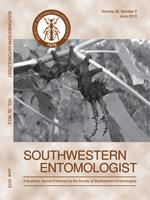The pathogenicity of 10 isolates of Beauveria bassiana (Balsamo) Vuillemin, and two of Metarhizium anisopliae (Metschnikoff) Sorokin, was evaluated against adults of the maize weevil, Sitophilus zeamais (Motschulsky). All isolates were pathogenic at a concentration of 1×109 conidia/ml, averaging 53 to 93% mortality, and a lethal time TL50 of 3.5 to 5.1 days. The B11-1 isolate from B. bassiana caused 93.3% mortality in 3.5 days, whereas M21 of M. anisopliae showed a rate of 53.5% mortality in 5.1 days. Under different temperature regimes (28, 30, 32, and 34°C) the fungal growth decreased. Cluster analysis resulted in medium, high, and low levels in relation with the percentage of mycelium growth inhibition by each isolate. The isolates of B. bassiana showed a diminution of growth of 28 to 79%, while isolates of M. anisopliae were 24 to 31%. The B. bassiana isolates were most patoghogenic than M. anisopliae against the insect; however, these fungi were most tolerant to warm temperatures at range of 28 to 34°C Therefore, M. anisopliae can be considered more useful for effective control of S. zeamais in maize storage facilities under these temperatures, a common scenario in Sinaloa, Mexico.
How to translate text using browser tools
1 June 2013
Selection of Beauveria bassiana and Metarhizium anisopliae Isolates Tolerant to High Temperatures for the Control of Sitophilus zeamais (Coleoptera: Curculionidae)
Rey David Ruelas-Ayala,
Cipriano García-Gutiérrez,
Arely Archuleta-Torres
ACCESS THE FULL ARTICLE

Southwestern Entomologist
Vol. 38 • No. 2
June 2013
Vol. 38 • No. 2
June 2013




